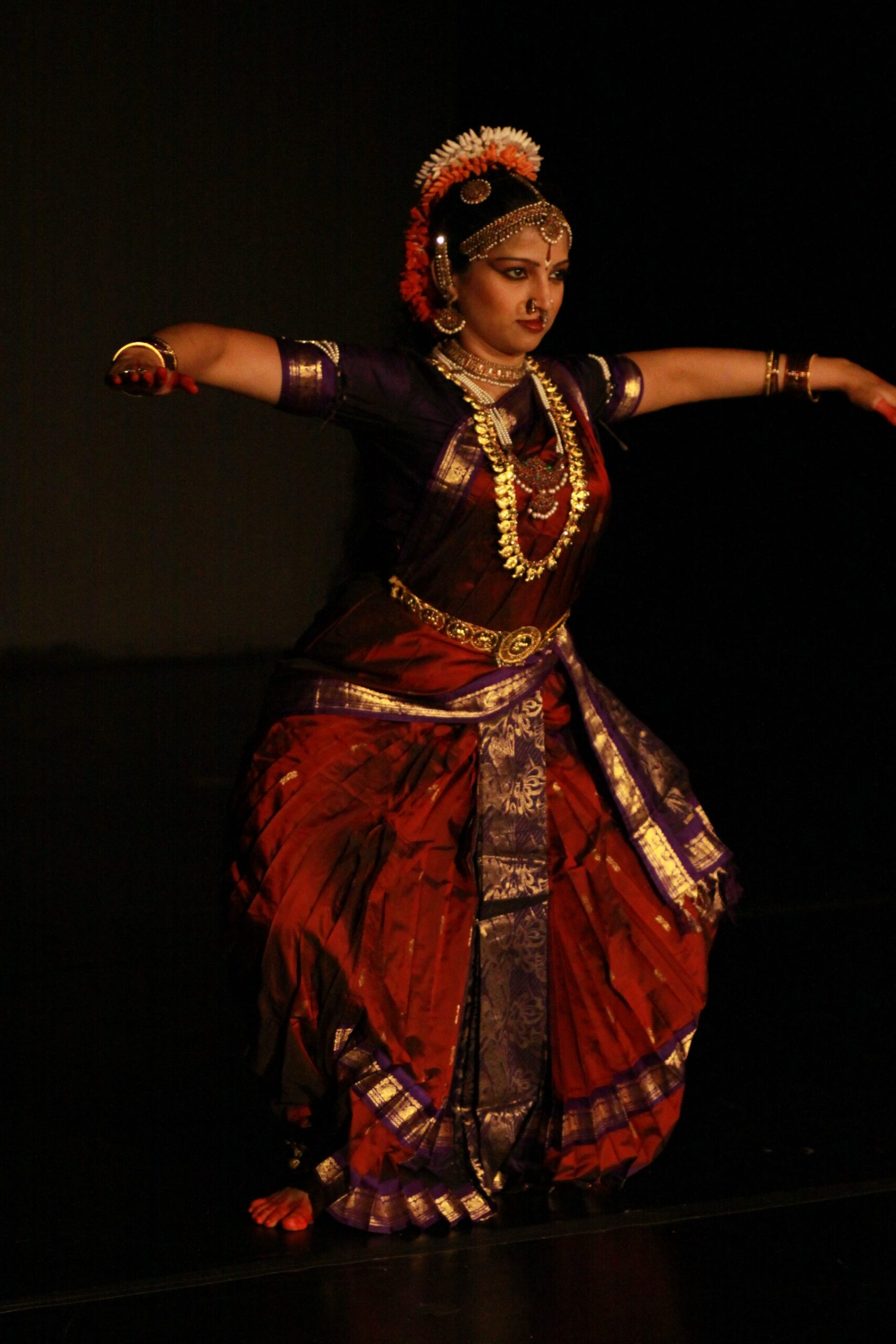DANCE THEATRE
Dance Theatre explores the works and productions originally conceptualized and choreographed by Srividya Angara Sinha.
While the lilt of Kuchipudi expresses itself naturally in traditional pieces of work, its fluid paradigm also lends itself readily and effortlessly to ideas that are contemporary in content and timeless in nature. Rooted in an ancient dance-drama tradition replete with expression, dialogue, and movement, and theatre is implicitly, intrinsically woven into the Kuchipudi form. Srividya delves into different themes harnessing precisely these attributes, creating productions that have received acclaim and applause at every showing.
Manomanthana
Manomanthana explores the journey of a seeker in modern times through the lyric of saint-poet Thyagaraja, interspersed with English poetry and prose. The theme of it is timeless, the choreography strong, graceful and rooted in ancient Kuchipudi grammar while the music is a harmonious coming together of classical and contemporary classical.
Manomanthana had its premiere under the aegis of IndicA, an organization dedicated to preserving Indian scripture and tradition, where it was presented for the very first time in front of the Rama idols that Sri Thyagaraja himself used to worship, in Thanjavur; and later at the Navaneetha Krishna temple (Thanjavur) and Pattabhi Rama temple (Thiruvayyaru).
In Bengaluru city, the production was staged at Jagriti Theatre, where two back-to-back shows were presented. Both recitals received a good response from the local community and even greater coverage in almost all the national dailies. At Hyderabad, Manomanthana received a STANDING OVATION from a full house. The audience at all showings were very moved, proving that a good work of art cuts across professions, communities, terrains, and cultures.
Press and Reviews
mel - CHOREOGRAPHIC INTENT
A Kuchipudi choreography set to Beethoven’s 5th Symphony. Choreography, concept and presentation by Srividya Angara.
Mel- a Hindi word for ‘coming together’ paints a scene from the Mahabharata – India’s great epic poem. It tells the story of the great dice game between the good Pandavas and wicked Kauravas, of Queen Draupadi’s humiliation in court and her subsequent vow.
The choreography begins by invoking the almighty Lord Nataraja, the “Lord of dance”. Through movements of Kuchipudi, it is portrayed that His body is the Universe in its entirety, and that the Sun, the Moon and the sacred Fire are His three eyes. The movements then proceed to depict that His body is covered in ashes, and that He wears the skin of a tiger around his waist, holds the trident and the drum, and whose ornaments are the most venomous of serpents. In conclusion are depicted His radiant, ubiquitous energy and His great matted locks where from bursts forth the sacred Ganges Herself. Unto that Lord Nataraja, the dancer bows and offers her worship most reverently.
The story begins thus.
Draupadi was the queen and wife of the five good kings, collectively called the Pandavas. Righteous, and brave, the Pandavas were wise in mind and strong in body. Their popularity gnawed at and burned the insides of the evil Duryodhana –their cousin and arch enemy. Finally he hit upon a plan. A most devious game of dice was planned, knowing that the eldest of the Pandavas had a weakness for it.
Through calculated deceit, Duryodhana takes away all their possessions. When the Pandavas had in the end lost themselves too in the wager, Duryodhana willfully suggests that they pawn their beautiful wife Draupadi. They eventually agree and as fate would have it, she too is lost. The evil one then orders his brother to drag her by hair into full court, and orders her to be disrobed.
Draupadi is horrified and begs for all the virtuous in the court to come to her aid, to speak up. Silence alone, however, greets her. She then turns to Lord Krishna and prays that He come to her rescue. And lo and behold! The wicked younger brother pulls at a garment that shows no sign of ending. Exhausted, he gives up. And it is then that Draupadi, consumed with mad rage and grief takes a terrible oath. She vows that unless the younger brother’s blood, blood obtained by ripping open his chest, is mingled with her hair; she will not tie her tresses into a knot.
Thus ends the story on the Queen’s vow. At this point the choreography too concludes.




Testimonials
It is an exciting work and I hope the
choreographer continues to develop her point of view to
cultural fusions of Kuchipudi that honors the traditions
of the movement through non-Indian musical forms.
Charles O. Anderson
Interesting choice to use this music and the
sounds of your costume worked so beautifully with
Beethoven’s score.












